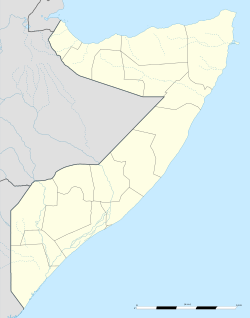Galdogob
|
Galdogob Galdogob جلدجب |
|
|---|---|
| Town | |

Aerial view of Galdogob.
|
|
| Location in Somalia. | |
| Coordinates: 7°1′52″N 47°1′14.5″E / 7.03111°N 47.020694°ECoordinates: 7°1′52″N 47°1′14.5″E / 7.03111°N 47.020694°E | |
| Country |
|
| Regional State | Mudug |
| Region | Galdogob |
| Government | |
| • Mayor | Hassan Mohamed Farah |
| Elevation | 373 m (1,224 ft) |
| Population (2005) | |
| • Total | 40,433 |
| (District) | |
| Time zone | EAT (UTC+3) |
Galdogob (Somali: Galdogob, Arabic: جلدغب), also spelled Goldogob, is a town wholly administered by the government of autonomous Puntland as the capital of the Galdogob District within the Mudug province. The town technically straddles the disputed 1950's-era Provisional Administrative Line (as depicted on virtually all worldwide maps, atlases, and geographic websites) that separates the Ogaden region of Ethiopia from north-central Somalia.
Galdogob is located in the western part of the Mudug region bordering Ethiopia's portion of the Somali-majority Kilinka Shanaad and is a popular rest stop for Somali travelers heading to and from Addis Ababa, Werder, Djibouti, Jijiga, Dire Dawa, and Geladi. Over 100 small cars and heavy trucks pass through the city every day.
Galdogob is a rapidly growing town and is populated mainly by the Tanada Darood tribe. It has a very reliable electricity and telecommunications network. The district's fresh water is provided by the Galdogob Water System (GWS), which was founded by a group of local businessmen.
All this has helped Galdogob develop into a relatively large urban area for this region. Visitors to Galdogob will find high-speed internet cafés, hotels, taxis, and other amenities. Education plays a vital role in the lives of the people, and private schools teach computer skills, English, mathematics, science, and Islamic studies.
Galdogob also has a thriving industry: hundreds of thousands of camels, sheep, goats and cattle are purchased here and shipped through the busy port of Bosaso every year. The city's livestock trade is at its most brisk during the hajj period, when over a hundred thousand heads of livestock are sold and shipped to the Gulf states, again through Bosaso. Galdogob has recently also seen the arrival of migrants from the more southernly areas of Somalia seeking work and a safer place to live.
...
Wikipedia

